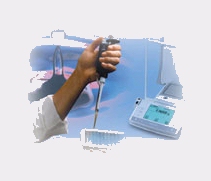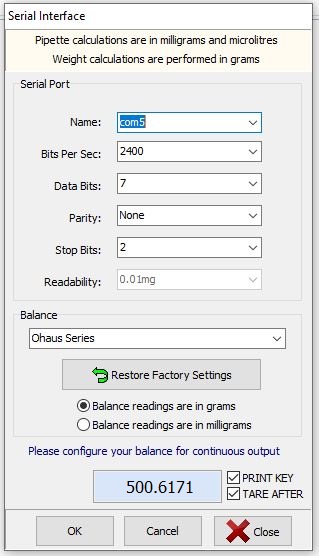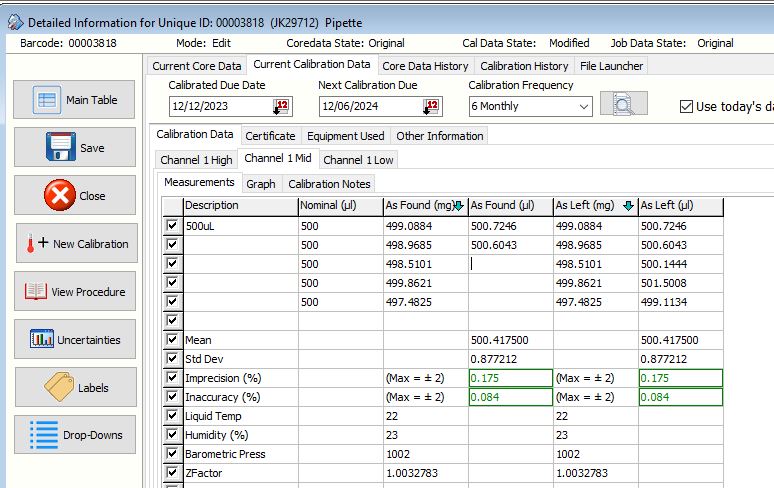

A pipette is a laboratory device used in chemistry, biology and medicine to dispense a measured volume of liquid from one container to another.
Regular calibration and servicing are essential and, in addition, pipettes also require frequent checking for accuracy before use. This validation, as it is sometimes known, can be carried-out on a daily, weekly or monthly basis depending usage.
Gravimetric pipette analysis is one of the most accurate ways of calibrating and validating pipettes and is by far the most widely-used method.
The technique involves weighing the volume of liquid (usually de-ionised water) dispensed by the pipette (known as an "aliquiot") and converting the weight into the equivalent volume using what is known as the Z-FACTOR (which is very closely related to density and specific gravity).
Readings are repeated (usually 5 are taken) for three volumes that cover the range of the pipette (Low - 20%, Medium - 50% and High - 90%). So, for example, if a 200 µl pipette were being calibrated, we would record the following measurements:
| 5 readings at 40 µl | |
| 5 readings at 100 µl | |
| 5 readings at 180 µl |
Up to five aliquots are dispensed for each of these volumes although it is possible to record more if required.
Water evaporation is an important factor and this must either be compensated-for, or made negligible by use of a vapour-trap.
Pipettes can be single-channel or multi-channel devices.
Multi-channel pipettes (eight, twelve, sixteen etc) simultaneously dispense the same volume from each channel over their operating range. Each channel is calibrated as if it were an individual pipette. Normally all tips, with the exception the pipette channel being calibrated, are removed.
The volumes at each setting are analysed and two values calculated:
| Imprecision: | A measure of the repeatability of the pipette | |
| Inaccuracy: | A measure of the closeness to the required value |
Balance Interface
Gravimetric pipette analysis can involve a lot of repetitive, manual work. From dispensing each aliquot and recording its weight, to performing the calculations and analysis. Each step has to be carried-out carefully and accurately. Thankfully both the workload and the chances of human error can be reduced significantly by using Calibration Toolbox ADO.
If you use Toolbox's in-built "Pipette" calibration data type, recording the appropriate measurements and performing the calculations becomes a relatively straight-forward process that will help you comply with the demands of GLP and ISO 17025. Furthermore, the chances of error are also much reduced.
Fundamental to our support for pipette calibration is Calibration Toolbox ADO's laboratory balance interface.
This enables you to connect your balance to the software using either RS-232 or USB - whichever your balance has. The following balances are supported:
- Mettler Toledo
- Ohaus
- A and D
- Sartorious

The balance interface is simplicity itself, and all of your settings will be remembered. Simply select:
- The type of balance
- The serial port and communication settings
- Balance output units (g or mg)
- The balance's readability (if available)
Then, looking near to the bottom of the window, ensure that the following two boxes are checked:
- PRINT KEY
- TARE AFTER
This will enable the balance to send its latest reading to Calibration Toolbox ADO and then tare the balance to 0.0 ready for the next aliquot.
Then, with reference to the picture below: the user simply needs to:
- Position the mouse cursor and click the first cell for data entry
-
Dispense the aliquot and press the PRINT button on the balance
This will put the reading into the cell and move the cursor to the next cell DOWN to the next position ready for the next aliquot - Click "Calculate" when the As Found test point is completed
- The user will then repeat items 1 to 3 above for the other As Found points and then the As Left if necessary

As you see, the need for writing down readings and then transferring them at a later date has been eliminated.
All the calculations are performed in accordance with internationally accepted guidelines.
Pipette Video Tutorials
We have created a set of short video tutorials to demostrate how how simple and accurate routine pipette
calibration becomes when you use Calibration Toolbox ADO and the Site Technician remote data entry module.
They are available in two standard video formats: *.mov and *.mp4:
| 1. Introducing Calibration Toolbox ADO | |
| View in mp4 format | View in mov format |
| 2. Test Plans and Calibration Procedures | |
| View in mp4 format | View in mov format |
| 3. Creating Worksheets for Site Technician | |
| View in mp4 format | View in mov format |
| 4. Calibrating Pipettes Using Site Technician | |
| View in mp4 format | View in mov format |
| 5. Importing Calibration Data and Making Calibration Certificates | |
| View in mp4 format | View in mov format |
